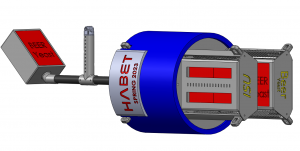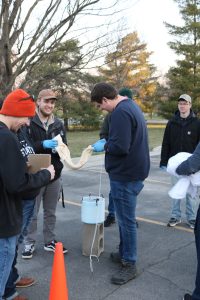Module Redesign (Spring 2023)
The Engineering team has created an improved design that offers a lot of quality-of-life improvements. The new design reduces the weight, increases the payload space, maintains structural strength, is more modular, and reduces the influence of wind on our spacecraft. With this new space-craft design, we needed to develop a new way to provide thermal protection to the internal electronics. So we devised a system of interlocking foam pieces that are screwed to the structure inside.
Updating HABET’s Avionics (Spring 2023)
Continuing our improvements from last semester, the Engineering team is looking to increase the reliability of our BERT (Backup Emergency Recovery Transmitter) and HAR (High Altitude Reporter) systems. The initial step in this improvement is to move HAR from breadboards to custom printed circuit boards. The boards have been designed and printed, and assembly is nearing completion. We hope to test our new and improved HAR units on our upcoming flights. In the future, the team hopes to transition both systems to the MicroMod board ecosystem, which will allow much greater modularity and reliability.
Flight LX-164-A: New Member Training Flight (Spring 2023)
Flight LX-164-A was conducted on April 7 as a training flight for our new team members. It consisted of a simple avionics payload (BERT and Spot) and a video camera for capturing the balloon burst during flight. The flight was overall a success, as each team gained valuable experience and successfully completed their goals for the flight.
UPCOMING: Flight LX-163-B: Beer Yeast Flight (Spring 2023)
Our next flight, LX-163-B, is scheduled to happen in the coming weeks. The goal of this flight will be to record the launch of 3 packets of beer yeast to a high altitude. The Engineering team has created special camera mounts and holders for the beer yeast, which can be fitted to HABET’s standard cylindrical spacecraft.
Launch Platform (Spring 2023)
This semester, the Experimental team is building a mobile launch platform, which will greatly help HABET with some of its future projects. The base of the platform has been constructed, and all parts have been ordered. Currently, the team is testing the remote launch system, which will use a relay to heat a nichrome wire and release the balloon from a distance. The platform will also include a flow meter, which will be used to precisely measure the amount of gas being put into the balloon. This will allow for more accurate balloon fills, which will make flight predictions more accurate and cut down on potential wasted gas.
Deployable Parachute (Spring 2023)
The Experimental team is currently working on creating a deployable parachute system. So far, the team has created initial CAD models of the container and conducted a successful test of a drag ribbon system that would keep the spacecraft oriented in the correct direction. Code has also been written to deploy the parachute at a specified altitude. Currently, the team is working on developing an effective, reliable method for deploying the parachute from the container.
HABET Wiki (Spring 2023)
The Operations team has created a GitHub Wiki page for the HABET team. The purpose of this page is to provide a centralized location for all training materials, flight documentation, launch procedures, and equipment specifications.




